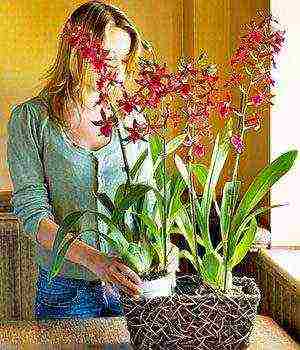Content
- 1 Description of pansies
- 2 Viola daily care
- 3 Growing pansies from seeds
- 4 Vegetative propagation of flowers
- 5 Varieties
- 6 Reproduction methods
- 7 Sowing dates
- 8 Collection and preparation of seeds
- 9 Sowing seeds
- 10 Seedling care
- 11 Picking
- 12 The soil
- 13 Wintering
- 14 How to plant seedlings at home
- 15 Preparing a container and soil for a tricolor violet
- 16 Care, diseases and pests of seedlings
- 17 Diseases and pests
- 18 Preparing the garden for planting
- 19 Conclusion
Viola can be sown directly into open ground, but it is often grown through seedlings. Sowing at home or in a greenhouse allows you to carefully care for each seedling, which means fewer seedlings die, which saves seeds. This is important if you have few seeds - for example, you bought a beautiful, expensive variety. Also, pansies are sown on seedlings when they want to get abundant flowering in the very first summer. For example, when growing viola in balcony boxes and flowerpots, you need it to bloom magnificently already in the year of sowing, which means you need to sow earlier than in open ground.
When to sow pansies for seedlings
The term for sowing viola for seedlings in the middle lane is from 1 to 10 March.
Viola soil mix Land mixture for sowing can be used ready-made, purchased in a store. To help the seedling roots develop better, add a little washed sand to the purchased soil. You can prepare the soil for viola seedlings yourself. Mix equal amounts of turf or garden soil, peat, humus and sand. Stir the mixture and sieve. So that the seedlings are not affected by the black leg, steam the prepared mixture in a double boiler for an hour. Steaming will destroy not only pathogens, but also weed seeds.
Fill a sowing dish with damp potting soil and compact slightly. Spread the viola seeds evenly over the soil surface. The easiest way to do this is with a small piece of paper.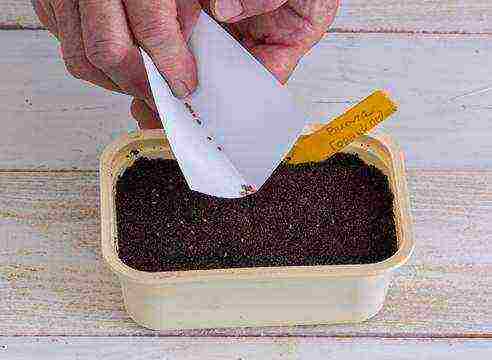
You need to water the crops using a fine spray. Moisten the soil surface liberally.

Cover the bowl with glass or place it in a clean plastic bag.
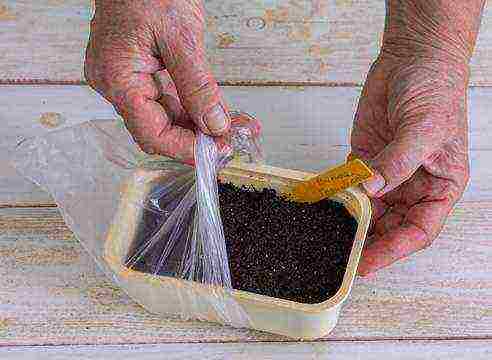
Pansy seeds do best in the dark, so place the bowl in a warm, dark place. At a temperature of + 22 ° C, viola shoots appear 7-10 days after sowing. After emergence, place the bowl in a sunny place.
Make sure that the soil remains moderately moist at all times, and that drops after watering do not remain on the leaves. Remove the shelter a week after emergence.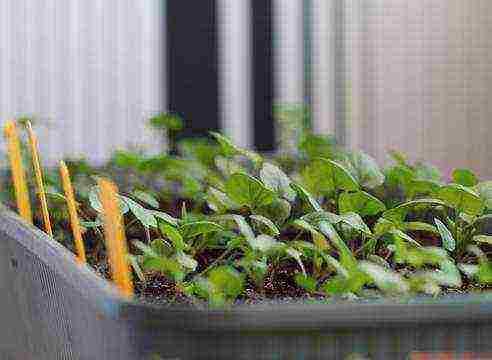
Picking viola seedlings When the seedlings of pansies have 2 real leaves, it's time to dive.
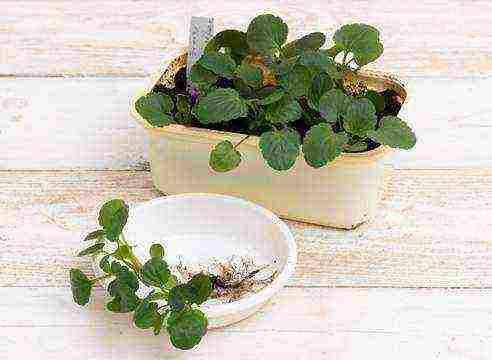
You can dive a viola into a box according to the 5x5 centimeters scheme, since it tolerates transplanting well at almost any stage of development, even during flowering. But such seedlings after planting in the ground will require more attention, because when planting from a box, the roots of the plants are damaged, and they need to recover. If you have enough space on the windowsill at home, then it is better to dive the pansies into separate pots.
The composition of the soil for picking is the same as for sowing viola, only there is no need to sift and steam the soil. Add to the soil mixture 1 tablespoon of mineral fertilizer (Nitrofoska, Azofoska) per 2 liters of the mixture. Mix well. Fill pots with it and condense a little. Plant pansy seedlings, one in each pot. When planting, make sure that the roots are freely placed in the hole and do not bend when filling it.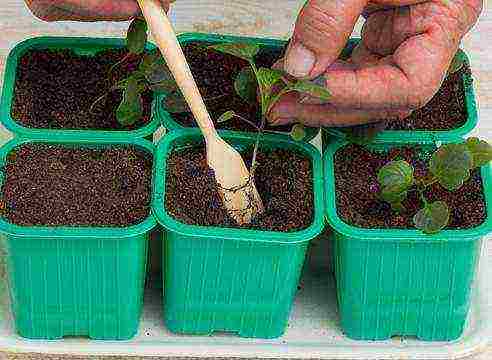
If the roots do not fit in the hole, then pinch them. Too elongated seedlings when diving, deepen to the cotyledonous leaves.Compact the soil around each seedling.
Water gently.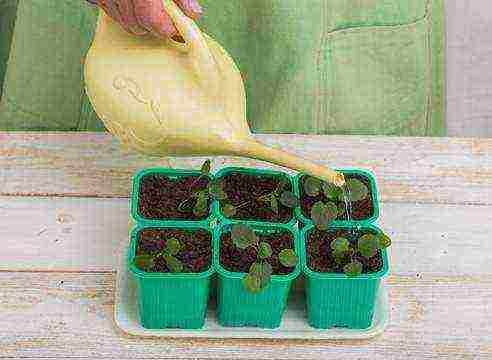
Start watering from the edge of the pot. If, as a result of watering, the soil has settled heavily, you can add it, but do not cover the cotyledon leaves.
Place the seedlings in a bright place. It is enough to maintain the temperature at the level of + 15 ... + 17. Monitor soil moisture. You need to feed the viola once every two weeks with a solution of mineral fertilizers for seedlings. With the onset of warm weather, seedlings can be placed in a greenhouse, greenhouse or on a balcony: where the temperature will not fall below 0 ° C. If you do not have this opportunity, then 2 weeks before disembarking to a permanent place, start hardening the seedlings, gradually accustoming them to open air. In warm weather, keep your pansy seedlings in partial shade to avoid leaf burns.
With proper care, by the end of May, the viola blooms and is ready for planting in a permanent place.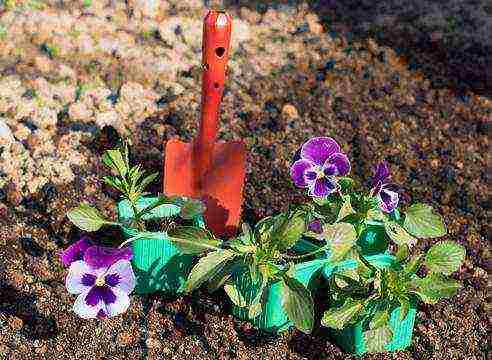
Planting viola in the ground
The soil for planting viola does not have to be fertile, but it is important that it is loose and breathable. Any cultivated garden soil will do. If the soil on your site is clayey and heavy, then fill it with peat and sand and apply a complete mineral fertilizer containing nitrogen, phosphorus and potassium at the rate of 30-40 g per 1 sq. M. Dig well.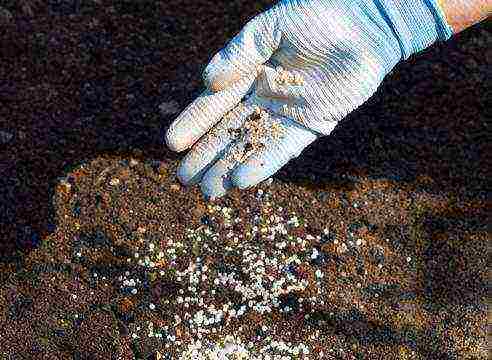
The scheme for planting viola in a flower garden is 20 x 20 cm.If you plant flowers in one row, then the distance between the plants can be reduced to 15 cm.Pansy seedlings are planted in holes with a small (about 1 cm) deepening of the root collar.

After planting, water the seedlings well.
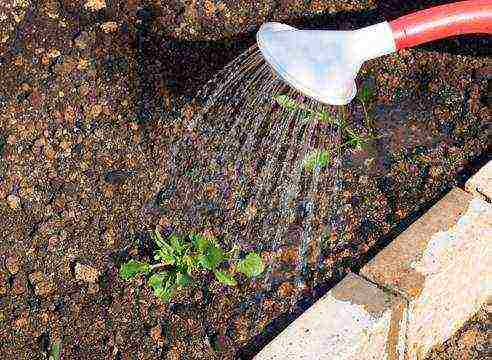
Further care consists in regular feeding, loosening and watering.
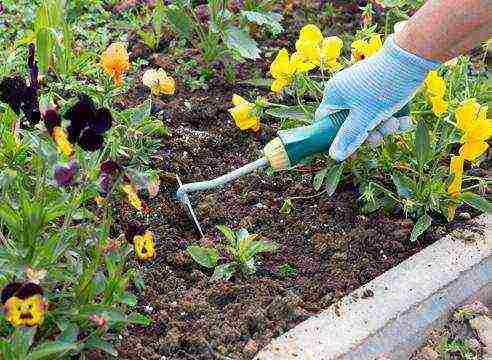
With a lack of moisture, viola quickly ends flowering, so the soil must be constantly kept moist. In order for pansies to continue to bloom for as long as possible, set seeds must be removed in a timely manner, especially for plants planted in boxes and containers. When planted in the ground, viola produces self-seeding. The dried bolls crack and shoot the seeds at some distance, so the next year after planting, the blooming viola can be found in the most unexpected places.
When the viola bushes have faded, cut them off, leaving 4-5 cm. After 2-3 weeks, new shoots will form from the dormant buds and flowering will resume, it will be especially abundant in the spring of next year.
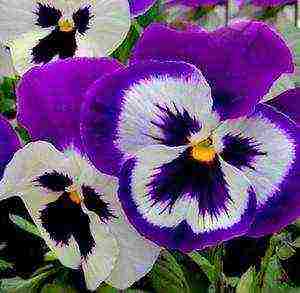 Pansies, which can be grown at home, rightfully occupy a leading place among the early flowers. There is a huge variety of colors - from white, pale pink to maroon.
Pansies, which can be grown at home, rightfully occupy a leading place among the early flowers. There is a huge variety of colors - from white, pale pink to maroon.
The great advantages of plants are early flowering, unpretentiousness, frost resistance, an uncomplicated breeding process, and ease of care.
Order
green beans
with home delivery from Instamart.
Free shipping promo code «
lediveka
»
Description of pansies
The correct name for this herb is viola. In the Ukrainian speech, you can hear another name - brothers, due to the fact that the flowers are very similar to each other, but not identical.
 The original viola variety has a bright blue color. Today there are over 500 species of pansies. Often they have a very rich two-tone color - petals of the same color are contrastingly combined with a brighter and darker core.
The original viola variety has a bright blue color. Today there are over 500 species of pansies. Often they have a very rich two-tone color - petals of the same color are contrastingly combined with a brighter and darker core.
Florists highly value pansies for the abundance of varieties and a variety of colors, thanks to which you can create a wide variety of compositions and harmoniously combine flowers with other types of decorative flora.
Flowers are most widespread in temperate latitudes, but despite this, pansies grow well in the subtropics. Climatic conditions make it possible to grow a perennial plant, but the most common varieties are those that delight with their lush flowering for two years, after which growers plant young plants.
Today, the flower has three most popular varieties:
- Violet of Wittrock;
- Norichnikovy;
- Tricolor violet.
Breeding work, carried out for more than a dozen years, has made it possible to obtain all kinds of hybrids of this plant that are resistant to high temperatures and do not stop flowering throughout the season.
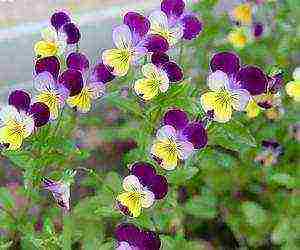 Flowers grow up to 30 centimeters long.The inflorescences are in the form of a decorative violet. Among other features of the plant are a fibrous root system, an erect main shoot. The bushes of young pansies have a compost shape and then become spreading. In the Russian climate, flowering begins in mid-April and can last until the end of summer.
Flowers grow up to 30 centimeters long.The inflorescences are in the form of a decorative violet. Among other features of the plant are a fibrous root system, an erect main shoot. The bushes of young pansies have a compost shape and then become spreading. In the Russian climate, flowering begins in mid-April and can last until the end of summer.
Viola daily care
Taking care of pansies doesn't take much effort. It is very important to choose the right place where the flowers will grow. HTo grow a strong, healthy plant, you need to plant it in slightly shaded areas, where bright sun will fall for several hours a day. The flower will ache in too shady areas of the garden. The same can be said about the hot, sunlit glades.
Watering is carried out depending on the degree of soil moisture. On rainy days, additional moisture of the substrate is not required. In hot summertime, it is necessary to water the flowers once every two or three days. It is important that moisture does not stagnate in the soil, otherwise it can lead to rotting of the root system. The size and number of inflorescences depends on proper watering - with insufficient moisture, they decrease in size and take on an unhealthy appearance.
Proper care, incl. watering, allows you to achieve continuous flowering throughout the summer season.
When planting flowers at home, the need for mineral feeding is rare. Pansies, unlike other ornamental flora, thrive in fertile soil and without feeding. Excess nitrogen fertilization can harm the flower, promote the development of fungal diseases, especially in conditions of high humidity.
Care provides for the timely planting of adult plants. Ideally, the distance between two bushes should be about 10 - 20 centimeters. Dense growth can lead to stagnation of moisture in the soil and the spread of the decay process. To grow a beautiful flower, it is better to immediately foresee the correct distance when planting it.
Growing pansies from seeds
Flowers need to be planted in soil with good drainage so that the plant does well and does not grow in moisture. You can grow pansies from seeds or green cuttings. The most inexpensive way would be to grow seedlings on their own for their further planting in the soil.
To grow seedlings from seeds, it is necessary to plant the plant in specially treated soil in an open space, or in a special nursery. Caring for the first shoots is not laborious - it is enough to timely water and loosen the soil between young shoots. From the time of planting the seeds in the soil to the growth of seedlings, 6-14 days pass.
Young shoots must be immediately planted in the place where the plant will winter. You cannot wait long, otherwise young shoots grown from seeds will take root and grow, which will negatively affect the flowering of pansies in the future.
In the next season, correctly planted flowers will delight you with lush flowering. In cold spring conditions, you can cover the plants with a transparent film. In addition to maintaining a comfortable temperature during the cold season, no additional care is required for the flowers.
Vegetative propagation of flowers
When buying seeds, there is never an exact guarantee that a plant will grow from them with the characteristics precisely indicated on the package. Poor-quality seeds may not germinate at all, or give weak shoots that are unsuitable for further picking and planting. On this side, the vegetative propagation method is more reliable. It guarantees the preservation of a pure variety of pansies.
To grow a flower in a vegetative way, it is necessary to choose strong, healthy cuttings, which have 2 - 3 nodes. The most suitable period for such a procedure would be from May to July.It is necessary to plant such shoots very tightly so that the leaves come into contact with each other - up to 400 plants can be planted per 1 square meter. After the procedure, it is necessary to irrigate the cuttings with water using a spray bottle.
Caring for planted cuttings consists in thinning cuttings, timely watering and protection from negative environmental factors.
You can cover the plants with paper dipped in water to create a favorable microclimate. Rooting usually occurs one month after planting. The flowering of young plants begins closer to autumn, provided that they were planted no later than the first half of June. In October, it is better to transplant the cuttings to the place where the pansies will winter. Full bloom occurs next year.
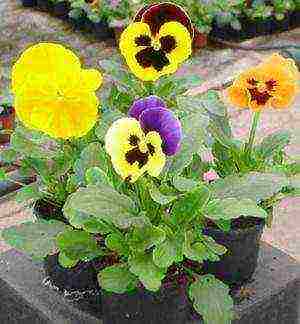 The vegetative method allows you to rejuvenate old plants. In the third year of life, the bushes of pansies grow to the detriment of flowering, so this "rejuvenation" allows you to achieve exuberant flowering of those varieties that already grow in your garden. Unlike propagation with seeds, planting cuttings allows you to get more plants. One mother plant can produce up to 45 cuttings per season.
The vegetative method allows you to rejuvenate old plants. In the third year of life, the bushes of pansies grow to the detriment of flowering, so this "rejuvenation" allows you to achieve exuberant flowering of those varieties that already grow in your garden. Unlike propagation with seeds, planting cuttings allows you to get more plants. One mother plant can produce up to 45 cuttings per season.
Pansy care is not too time-consuming and difficult. It is enough to choose the right place for the flowers to grow and water it in a timely manner. The flower can be grown from seeds or cuttings obtained from the mother plant. Subject to these rules, the viola will delight with lush and bright flowering throughout the summer.
Pansies are adorable and unpretentious. Decorate plots, balconies, city streets and parks. Their delicate petals and cheerful colors create a romantic mood. They belong to the violet family, in Latin they are called Viola (Viola).
These perennial herbaceous plants have many unofficial names: Ivan da Marya, scrofula, tricolor, brothers, half-color, moth. In this publication, we will look at how to grow pansy flowers from seeds, find out what care the plant requires, and also when to plant it.
Pansies - growing from seed
Varieties
The most famous are two types:
- Violet multicolor with small flowers. In colors, yellow is combined with purple or blue. Reaches a height of 30-45 cm. This type of violet is used in medicine for the manufacture of medicines.
- Violet Wittrock, which includes all hybrid varieties. They do not exceed 30 cm. In total, more than 400 species of viola grow on Earth, approximately 250 species are “domesticated”.
There are many different varieties of pansies.
The classification is based on different grounds:
- Flower sizes (small: up to 4 cm; large: 4-6 cm; giant: from 6 cm).
- The number of shades in the color (one-color: one color with thin stripes or specks; two-color: the lower and upper petals have different colors; spotted: they stand out in sharp contrasts).
- The height of the bush (it ranges from 10 to 30 cm).
- The shape of the edge of the petal (whether it is smooth or wavy).
Pansies are grown. as annuals and biennials. It makes no sense to preserve the perennial longer - in the third year the flowers become smaller, the viola grows. Watered once a week, during the rainy period - as needed.
Interesting: Zinnia: growing from seeds, when to plant, photo
Reproduction methods
- If you want to preserve all the properties of a varietal hybrid, cuttings are used. Green cuttings with 2-3 internodes are cut at the beginning of summer and planted in a prepared bed to a depth of half a centimeter. Create additional moisture: shade and cover with dampened paper. Water, irrigate and weed systematically. After 4 weeks, 95% of the cuttings will be rooted.
- The least commonly used division of the bush, and only in perennial culture. The bush is divided into several inflorescences and each is planted in a separate hole. Sprinkle, water and crush the soil.
- Seed propagation at home and in the open field.
The last method requires more detailed consideration.
Sowing dates
Pansies begin to bloom in 60-70 days from the moment of sowing. Planting dates are calculated based on the desired flowering time:
The appearance of the first shoots
- If you want anyutki to decorate the flower bed this summer, then seeds for seedlings are planted in February-March of the same year. Part of the seedlings can be planted not in the garden bed, but in pots or balcony boxes.
- When flowering is required already in early spring, seeds are sown in late summer or autumn, so they will take root in winter and grow.
- If flowering is desirable in late summer or September, seeds are sown directly into open ground in May or early June.
As they bloom, old buds should be removed. This will prolong the flowering period and preserve the decorative effect of the viola. Pinching is recommended to stimulate the development of lateral shoots. This will increase the number of flowers on the bush.
Collection and preparation of seeds
The peculiarity of pansies is that they are cross-pollinated. At the same time, the flowers become smaller and change color, they lose specific features. Therefore, the growth of fallen seeds is not able to become the pride of the garden. To obtain decent seed, you need to maintain a large distance between varieties. Seed pods of the strongest plants are selected. They are carefully collected when the color of the boxes changes to yellow, and dried.
Seeds can be treated with growth accelerators before planting. This will increase their resistance to disease. For preliminary soaking, "Epin" and "Zircon" have proven themselves well.
Sowing seeds
The optimum temperature in the first week after sowing is 20 degrees Celsius. When sown in open ground, flowering is expected next year. After all, the bushes need time to get stronger. If the bed is in a nursery, after a week, at most 10 days, shoots can be expected.
Seedlings of pansies
You can also sow in special containers. At this stage, there are no packaging requirements. Can be used:
- plastic and wooden boxes;
- special trays for seedlings;
- cardboard and peat cups;
- peat tablets;
- disposable plastic cups;
- containers made by hand from plastic bottles, juice cartons or other food products.
Thin grooves are drawn in the ground, in which the annuta seeds are evenly spread. Then they are covered with moist soil. The box is placed in a dark place, covered with glass or plastic. From time to time, the boxes ventilate and moisturize the substrate. Seedlings will appear within a week and a half.
Seedling care
When the seedlings hatch, the boxes are moved to the sunny (south) window. They monitor the moisture content of the soil. It is important to avoid stagnant moisture, pansies do not tolerate it. Waterlogging causes black leg disease. A week after moving, the shelter is removed from the box.
Viola needs long daylight hours (up to 15 hours). With a short daylight hours, it stretches. This can be easily avoided if the seedlings are illuminated with special phytolamps or LED lamps.
Plants can be transplanted only after the leaves appear. Approximately 8-9 days before disembarkation, the boxes are taken out into the open sunlight for hardening. It can be a balcony or a veranda, and from April - a street (at a temperature of at least 10 ° C).
Types and terms of work when growing viola
Picking
When the first pair of real leaves appears on the sprouts, you can start picking. Pansies tend to take root well. Even flowering bushes are transplanted. There is no need to shake off the soil from the roots - the planting will go smoothly while maintaining an earthen coma. When picking, the central root is pinched for better root formation.
The sprouts are transplanted immediately to a permanent place - in a flower pot, on a flower bed.A distance of about 20 cm is maintained between the plants, so that the bushes have room to grow. It is necessary to ensure that the levels of the soil and the earthen coma coincide. Then there will be no decay or dryness of the roots.
Seedling picking
If the seedlings are too elongated due to lack of light, they will have to deepen to the cotyledon leaves. The wells should be of such a size that the roots in them do not bend. If they still do not fit, you can pinch the ends of the roots. After sprinkling the roots with soil, it is moistened and crushed.
Interesting: When to sow pepper for seedlings in 2018 according to the lunar calendar
Planting is not carried out in bright sun. After 20 days after sowing, viola can be fed with nitrogen, phosphorus or potassium. These substances will increase the growth rate of young bushes.
The soil
Viols do not like rocky, sandy and dry ground. The acidity level needs to be neutral. You can buy soil for containers or make your own. Mix in equal parts:
- peat;
- sod land;
- sand;
- humus.
The resulting substrate is sieved and steamed for disinfection. Before planting on the site, it is advisable to fertilize the soil with mineral fertilizer. Nitrofoska and Azofoska are suitable at the rate of 1 tablespoon per 2 liters of soil. If the soil is acidic, lime must be added.
Important! Manure is contraindicated for pansies.
Wintering
To avoid blackleg disease, pansies are not placed in lowlands, where excess moisture can accumulate. In relation to light, the plant is quite light-loving, but not tropical. Therefore, in the south, it is recommended to choose slightly darkened places in order to prevent burns and lethargy of the leaves in the midday heat.
In central Russia, a viola growing in the shade is gradually degenerating. The flowers are crushed, the rich color is lost, the stems stretch and turn pale. Therefore, pansies are placed on flower beds, which are exposed to sunlight for at least 6 hours daily.
Transplanting seedlings into open ground
Anyutki love oxygen, respond well to loosening. For the winter, two-year-old bushes are covered with spruce branches, straw or fallen leaves. In the event of an early thaw, there is a danger of water stagnation and freezing during night frosts. To avoid this, a shallow trench is dug along the garden bed for the outflow of the water thawed during the day.
In the article, the reader learned what pansy flowers are, about growing them from seeds and when to plant a plant correctly.
How to grow pansies. Garden World site "
Pansies are a very beautiful and unpretentious variety of flowers, which is also called tricolor violet or Viola, and among the people - Ivan da Marya. You can decorate a garden plot with it early enough - on the first fine May days.
Pansies love growing from seeds when planting experienced gardeners is also easy to determine. For this, the date of disembarkation in open ground is scheduled (in accordance with the lunar calendars or according to the weather forecast), and approximately 90 days are subtracted from it. At this moment, you need to plant flower seeds at home.
Why is it best to germinate these types of violets at home? Because, firstly, like few other plants, they survive transplanting surprisingly easily. Even if the roots are damaged (which is not very rare when planting on open ground), the sprout still quickly comes to life. Secondly, the flower quickly begins to bloom and delight others with beauty. And in some cases, when the seedlings are bought (or grown on their own) are already blooming, then there is no need to wait for the formation of inflorescences. 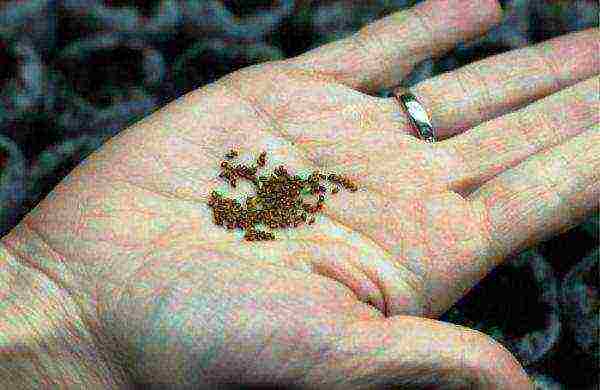
How to plant seedlings at home
Basically, the tricolor violet is used to decorate garden plots, vegetable gardens, flower beds. She feels good at home, on balconies and verandas.
There are both annual forms of these flowers and perennial ones.Today, many hybrid forms have been bred, which differ from each other in colors, shapes of inflorescences. The most popular are annual species, as they require less attention, but at the same time they bloom profusely and beautifully.

There are also varieties of different forms of growth. Some representatives of Pansies spread densely on the surface of the earth, while others form into beautiful, regular bushes with large, but rare flowers.
Growing methods of growing Pansies from seeds are very popular in horticulture. You can buy them in many specialized stores, because they are often in good demand and are readily sold. The seedling method of growing does not require high costs, since any seeds are cheap than a sprout already germinated and ready for planting.
Usually, in central Russia, they start planting at the beginning of March. The interval from 1 to 10 is well suited for this purpose. With normal development, the flower will be ready to move to open areas in late May - early summer. The weather will be warm by that time, so the flowering will continue for a long time.
However, some gardeners who prefer to sell ready-made seedlings can start sowing in January-February or even at the end of December. Of course, they are forced to use artificial lighting and prevent temperature drops in the place where the seedlings grow. But in the spring they can already sell fully formed and ready-to-plant bushes of tricolor violets, which in some cases even bloom. By the way, these flowers can be safely transplanted even in a state of flowering.
Pansies are not very demanding on the ground. It is only important that the ground is loose enough and easily let air through. The temperature regime for seeds is quite suitable for the one that is maintained in the room in its normal state. Watering also does not require any special skills. So, for sure, even a novice amateur gardener will cope with growing seedlings of these wonderful flowers.

Preparing a container and soil for a tricolor violet
Pansy seeds can be sown both in purchased soil, or you can prepare the base yourself. In general, a lot depends on the number of seeds that you plan to grow.
If there are few flowers, then you can limit yourself to buying ready-made soil or use modern and very popular peat tablets. By the way, they absorb moisture well and retain it for a long time, which is why they are ideal for growing all garden crops for seedlings.
If there are a lot of seeds, then it would be a good idea to save some money and prepare the basis for the soil on your own. This does not require much effort. It is enough to take ordinary land from your site, add sand and a little peat there, so that the resulting mixture has sufficient air permeability. You can add a little humus for fertility. In order to protect the seedlings, gardeners advise steaming the resulting soil for about an hour. This will destroy the weed seeds that may be in the soil and kill the larvae of pests and pathogens.
Another potting mix is garden soil and compost mixed in equal proportions. Such soil is harvested most often in the fall, and in early spring it is distributed in pots or other dishes prepared for seedlings. The mixture is allowed to settle for a day, moisturize and start planting.
Any containers for tricolor violets will do. You can use both small cups in area and plant a little seed in them, as well as wide pallets. You just need to moisten the soil well and tamp it.
There are two ways of planting seeds in a container:
- At the first, the seeds are simply scattered evenly over the area of \ u200b \ u200bthe seedling dishes.Since the seeds are small, for convenience, you can pour them onto a sheet of paper and gently pour them onto the ground. At first, pansies do not like light, so the seedlings are covered and placed in a warm place, where the temperature should be around 20-22 degrees Celsius. Every day you should open a small greenhouse for 10-15 minutes and let the plantation breathe.
- In the second method, which is no less popular, shallow grooves are made in pots (less than a centimeter deep). A distance of 1-2 centimeters is maintained between the beds. Then the seeds are planted at small intervals (also 1-2 centimeters between them). Gently sprinkle it on top with earth and cover it with a lid or a transparent bag. With this method, it is not necessary to leave the dishes in a dark place: the seeds are already covered with soil.
It is necessary to water the greenhouse very carefully. It is best to use a fine-grained atomizer for this purpose. It is important not to fill the soil. The fine line between dry soil and flooded soil is easily understood by an experienced gardener.
Sometimes it is best not to water, but from time to time to moisten the soil in the pots. However, Pansies are a rather patient flower, so you have to try to ruin it.
Usually, the first shoots appear in about a week or two. However, today it is not uncommon for low-quality seeds that do not germinate at all. Or, plants are often found on sale that are long and are not stored correctly. Then the seedlings may appear later - up to a month from the moment of disembarkation.
Care, diseases and pests of seedlings
Pansies should be monitored periodically, but they do not require constant monitoring. More precisely, we can say that at the first stages it is important not to tighten it with the need to remove the lid or package from the seedlings when the first shoots appear. Since with the appearance of the first green shoots, you need to open the greenhouse and provide access to sunlight.
Attention! In fact, sunlight is essential for all types of plants. Of course, Pansies are no exception to the rule. But the conditions of central Russia (and, even more so, of the northern regions of the country) in March and April cannot provide enough natural light.
As a rule, at the beginning of spring, the sun sets quite early, therefore, at first, artificial lighting of the sprouts can be organized. For this, fluorescent lamps are most often used. As a rule, for proper growth, it is enough to do about 16 hours of daylight hours. It is possible and not so long to "light up" the plants, but remember that less than 12 hours of light for the sprouts will delay their development and, as expected, the timing of transplanting into open ground will be postponed.
Watering the seedlings is best done with a spray bottle. But this is done carefully. If small drops of water fall on the leaves, then they must be carefully removed.
After the sprouts have two formed leaves, then you need to dive the seedlings. As noted, the seeds of Pansies are small, so plants can spawn close to each other. They must be transplanted into small pots without fail as soon as they are ready for this. The size is quite suitable for cups measuring 5x5 centimeters.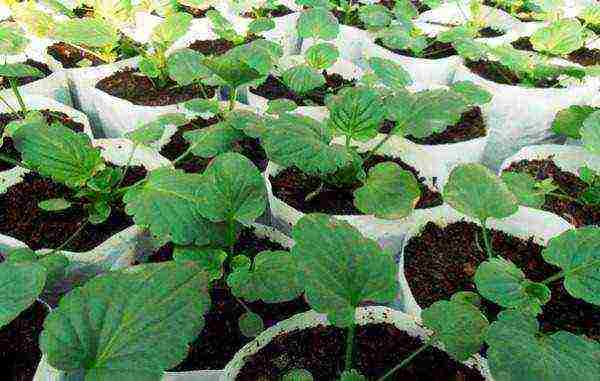
Before picking, you need to prepare the future soil for the flower. It is best to use the same soil that was used for the seedlings. For every two liters of volume, add a tablespoon of fertilizers rich in minerals for growth (well-known preparations such as Nitrofosk, Azofosk are well-suited). By the way, this time there is no need to calcine the potting mix or sift it.
Each sprout is planted in its own pot. In the process of working with seedlings, try to be neat with the root system. It is still poorly formed, and if it is damaged, then the growth of flowers can be slowed down.However, in case of urgent need, when the root has formed very large and branched so much that it does not fit into the hole, it will have to be shortened a little. This is much better than trying to wrap up the root system.
It is better to sprinkle plants almost to the very first leaves. The soil is compacted a little so that the seedlings sit stronger. Then you can water the sprouts. If using a watering can, pour water around the edge of the pot. Add a little soil if necessary.
On this, perhaps, the pick ends. An ambient temperature sufficient for normal growth is recommended in the range of 15-17 degrees. Then you just need to water and make sure that you feed the sprouts every two weeks. In addition to applying liquid mineral fertilizers, fertilizing diluted in water for irrigation will be a good help. For 3 liters, it is enough to dilute 1 tablespoon. It is better to apply with a sprinkler so as to get on the green mass. Wipe off excess drops from the leaves.
When the weather is warm outside, and the night frosts are over, you can take out the seedlings to fresh air. The main thing is to prevent drafts from walking freely on the tops of immature flowers at first.
And about two weeks before you plan to land on open ground, start taking the dishes with seedlings outside. At first, for such "walks" 1-2 hours daily will be enough. But each time you need to increase their duration. Just before planting, it is normal to leave seedlings in pots outside and overnight.
An important condition that should not be neglected: put Pansies in a shady place. Direct sunlight can burn the leaves.
Diseases and pests
Of course, if you do not see behind some factors, then Pansies can be affected by viruses or pests, the same ones that are destructive for many other representatives of the flora.
Powdery mildew or rust is quite rare on tricolor violets. When the first virus is infected, a whitish bloom appears on the entire green mass of the plant. In the second, yellow spots. In both cases, it is necessary, first, to get rid of the affected areas by carefully cutting them off. Secondly, treat the entire sprout with a 1% solution of Bordeaux liquid.
In case of severe waterlogging, adult plants can get sick with serious diseases. One of them is rot, which appears both on the roots and on the visible, aboveground part of flowers. It is expressed by the appearance of brownish spots, the gradual fading of Pansies. The only way out is to remove the affected flowers to protect healthy ones. It is then important to reduce watering.
Of the insect pests, most often you can encounter aphids, slugs and spider mites. Basically, they harm the greenery of flowers, gnaw holes, interfere with full and rapid development, spoil the appearance.
Some of them are quite difficult to deal with. Especially against slugs that feed on foliage at night. To combat them, boards are laid next to the flower garden and individuals are manually collected every morning. Then they destroy it. Ladybugs, which can be populated on flowers, effectively fight against aphids.
In dry weather, white light spider webs may appear on the leaves. On it, with magnification or even with the naked eye with sharp eyesight, you can see small spiders. Frequent spraying with plain water or a solution of water with laundry soap or loose tobacco helps to fight spider mites. If all else fails, then they resort to insecticide treatment (for example, a solution of fufanon in the dosage prescribed by the manufacturer).
Preparing the garden for planting
No special training is required. The soil in your garden may not even be very fertile.The only thing is, if the soil is very clayey, then it is better to add a little sand or peat to ensure sufficient air permeability.
It will not be superfluous to add top dressing. To do this, you can use nitrogen-containing, as well as phosphorus or potash fertilizers. The main thing is not to mix everything together, but to choose one thing. Or wait at least a week between different feedings. The sprouts are planted at a distance of 15-20 centimeters from each other. After all the procedures and dusting with earth, water the soil abundantly.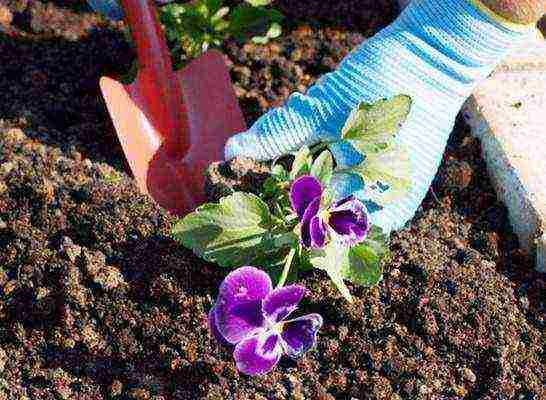
All further care of the beds will consist in periodic feeding, rather frequent loosening (since the flower loves porous soil) and watering. For feeding in an open area, liquid fertilizers are quite enough, which can be applied along with water (kemira is widespread).
Pansies do not like to starve without water, so one of the key features of long and abundant flowering is regular, but not over-watering. If you have a perennial plant, then after it has faded, cut the bushes, leaving 4-5 centimeters of the stem. The next year, this bush will again ovary and bloom. Many experienced gardeners also advise timely pinching off those inflorescences that have withered and faded. Then new buds will appear in their place faster, and flowering will last.
At the end of the season, you can find cracked bolls on Pansy's eyes, in which the seeds ripened. This means that next year you can find these beautiful, self-grown flowers in different parts of your garden.
Conclusion
Sooner or later, any gardener wakes up with an acute desire not only to grow a good, rich harvest on his site for food in the winter. With the advent of experience, I want to make my site more beautiful, neater, more elegant. And there is little else that can compare to when they resort to professional flower cultivation.
Probably, there is nothing easier than starting with breeding violets - easy to care for, not very demanding on environmental conditions and special, close attention to yourself. Pansies or tricolor violets (as well as Ivan da Marya) are a flower that is easy to find on sale, and also quickly diluted on your site. Therefore, when it comes time to plant Pansies for growing from seeds, do not miss this opportunity.
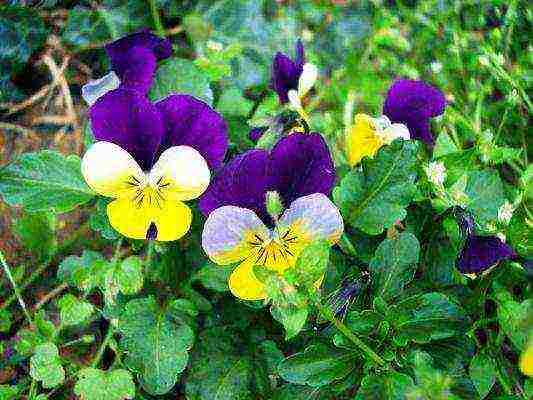
This business will definitely not cause much trouble, and when the time comes, your beds will be transformed and will delight you with beautiful flowering until autumn. And there will be no need to care for the plantings from morning to evening. In fact, only water on time.
In the future, the cultivation of Pansies will turn into an annual activity, because you can both plant perennial plants and independently collect seeds from the beds and, year after year, become the author of your own, unique flower arrangements.

